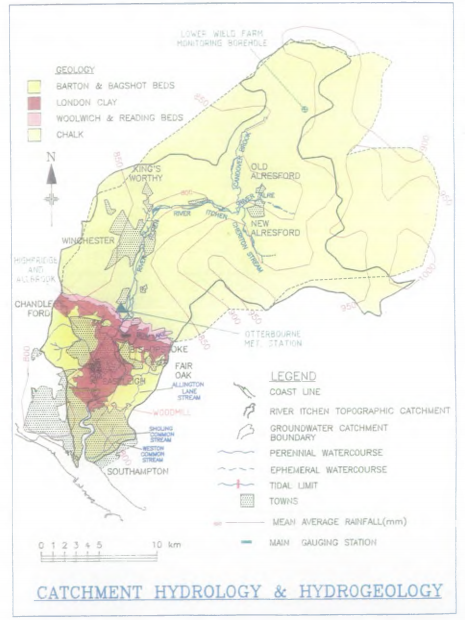Chalk is a highly porous and permeable rock, which means that water is able to pass through it. When rain falls onto an area with chalk geology the water seeps through the ground directly into the chalk, which then acts as an aquifer, meaning that the water is both stored and transpoted within the chalk. The groundwater then flows through the chalk bedrock, where it re-emerges in the form of springs. Due to the chalk acting as a temporary resourvoir for the water, many of the chalk stream in the UK have stable flow rates and the emerging surface water has a fairly stable temperature of 10°C.
In Great Britain chalk is the most important aquifer, accounting for more than half of the groundwater used in the country and 18% of the total water used in England and Wales. The importance of the Chalk as an aquifer is primarily due to its occurrence in the south of England, where population density is high, rainfall is low and there are few sites for suitable surface reservoirs. The Chalk also has a large outcrop area, over 21 500 km2, more than all the other major aquifers added together. The main property of chalk that allows water to pass through it, and therefore make it an important aquifer, are the complex network of macro and micro fractures that occur naturally within the chalk.
Chalk rivers and streams are a very rare and important environment, with only 200 known in the world and 85% of these are found in England. The combination of geology and climate in England means that the chalk streams and rivers have characteristics that creates perfect habitats for a wide range of flora and fauna. Due to the filteration in the macro and micro fractures of the chalk, the water is of high clarity and good chemical quality. It is this quality of water, as well as the gravels of the river beds, that make chalk streams and rivers so precious for invertebrates, including rare species such as fine-lined pea mussel, a range of mayfly species and damselflies.
This wealth of insect life provides food for a numebr of fish species, and the well vegetated banks and channels also provide shelter from predators. Chalk streams are important for fish species such as brown trout, Atlantic salmon, brook lamprey and bullhead. Further up the foodchain this provides for the otter, water vole, kingfisher, water shrew and white-clawed crayfish.
Chalk streams are also home to characteristic flora, many of which can be seen in the midde of the channel, such as water crowfoot and starworts. Typically the areas towards the bank have plants such as watercress and lesser water-parsnip. The surrounding floodplains of most chalk rivers contain unimproved wet grassland and fen and are of immense importance for the breeding of wader birds and wintering wildfowl. This mixture of flora, and crystal clear water make chalk stream on of the most beautiful and iconic of all our countries rivers. The identification of chalk rivers and stream, apart from the characteristic flora and fauna that they support, is often possible by looking at the sediments found in the bottom of the river. The channel beds often consist largely of angular flint, eroded from natural deposits in the chalk bedrock, with very little clay and silt deposits.
The River Itchen is one of the best example in Europe for a chalk groundwater fed river. The three main spring fed tributaries, the Candover Stream, the River Alre and the Cheriton Stream, all rise on the Upper chalk. As well as this the entire upper catchment area, before Eastleigh, is entirely within the chalk. The lower parts of the catchment area is on the succesively younger Woolwich and Reading Beds, London Clay and the Barton and Bagshot beds, which all overlie the chalk. This geology is shown in the map of the River Itchen catchment below.

Due to their rarity and importance to both flora and fauna, chalk rivers and streams are recognised as a priority habitat under the Uk Biodiversity Action Plan (BAP). Although often a chalk stream will progress into a chalk river, as is the case with the River Itchen, specific sites and streches on these waterways are often defined as either a river or a stream. Sites are generally considered to be ‘streams’ rather than ‘rivers’ when they are no further than 5km from their source or greater than 5m wide (unless they have been artificially widened).
To log this EarthCache you must look at the evidence availabe to answer these questions, either via email or messanger
Posted Coordinates
1) Look at the gravel on the river bed and state what makes up most of the larger pieces?
2) What type of rock does this commonly occur in and what does it indicate about the rivers geology at this point?
Walk to Waypoint 2
3) Look to the either side of the path, what type of environment do you see, and is this typical based on your conclusion of the rivers geology?
4) What is the clarity of the water, and how does this relate to the geology?
5) What are the last six digits of the the phone number on the small signs on the bridge?